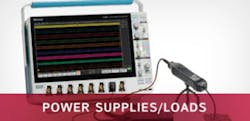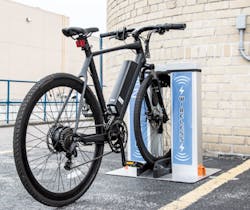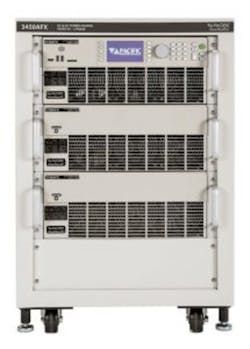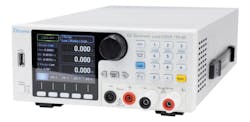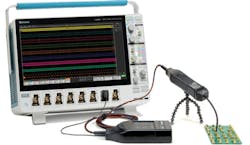In pursuit of clean power and efficiency in applications ranging from consumer to military and aerospace, vendors are making advancements in areas including power supplies and loads, semiconductor technology, and instruments that can assist in power measurements.
Jon Semancik, director of marketing, AMETEK Programmable Power, highlighted the breadth of industries that power technology serves. “AMETEK Programmable Power serves a growing range of applications, including commercial and military avionics testing, general R&D, automated testing equipment, electromagnetic compatibility (EMC) compliance testing, semiconductor fabrication, oil exploration, solar-array and battery-string simulation, AC power simulation, manufacturing and process control, and IEC standards testing,” he said.
As for challenges customers are facing, Semancik explained, “Our customers are always striving to reduce the footprint of any test system or simulation system they configure, and the high power density of our Asterion line (Figure 1) is one way that we’re helping them accomplish that.” He continued, “They’ve asked us for instruments that are easier to use and more flexible, and we think our intuitive touchscreen front panels go a long way toward achieving that goal. They also want instruments that simplify test setup and execution; the auto-paralleling function in the Asterion supplies make system configuration and synchronization simpler.”
Courtesy of AMETEK Programmable Power
Semancik elaborated on the company’s power-supply offerings. “Our Asterion high-power AC sources can output up to 3 kVA from a 1U package, and even higher outputs when multiple units are stacked. Our 3-phase, 2U sources offer similar power density advantages.” He said auto-paralleling capability simplifies stacking—allowing users to combine up to six units to achieve up to 18,000 VA of output power. “One unit becomes the master while the rest serve as auxiliary units,” he said. “Multichassis configurations like these are configured automatically when the chassis are interconnected with the interface cables. There’s no user setup required, except to wire the outputs. The chassis are automatically synchronized.”
Commenting on usability, he said, “In addition to the standard Ethernet LXI, USB, and RS-232 control interfaces and optional GPIB control interface, Asterion supplies provide an intuitive touchscreen interface. The touchscreen home page offers access to a menu of dashboards, output programming parameters, measurements, sequencing, configuration, control interfaces, applications, and system settings tools, all available with the touch of an icon. A dynamic rate-change algorithm adjusts the control resolution to combine precise control over small parameter changes with quick sweeps through the entire range. Output waveforms can be displayed through the touchscreen or the Asterion Virtual Panels Windows-based graphical user interface.”
He also commented on the company’s trademarked iX2 current-doubling technology.1 “The iX2 technology built into Asterion AC power sources allows overcurrent capability up to twice its nominal max current, resulting in a full 200% overcurrent capability,” he said, thereby allowing for full-power operation over 75% of the source’s voltage output ranges. “The iX2 current-doubling technology also eliminates the need to buy multiple sources or overpowered sources to run tests at different voltage levels, such as when performing low-line voltage testing,” he added.
For customers in the avionics testing business, he said, Asterion power supplies have a range of avionics electrical power quality test software packages developed for popular military and commercial aircraft. These avionics testing packages provide customers with simple-to-use testing solutions for which the intensive test sequence programming is done already.
Supplies plus loads
Chroma Systems Solutions offers a variety of equipment for power, safety, and component testing, said Larry Sharp, senior applications engineer. “Chroma’s R&D [team] creates hardware and software to support a variety of test requirements,” he said, citing as examples electric-vehicle, battery, smart-grid, energy-storage, medical, aeronautics, and military applications. Chroma’s equipment, he said, has been developed to support specific tests such as solar-array simulation for PV inverter test and AC regenerative grid simulation with programmability for testing grid-tied generators and inverters for efficiency. The equipment can also measure response times and regulation and determine reaction to power-line disturbances. The company’s DC loads with user-defined waveforms can simulate real-world loading for battery tests or can simulate LED loads for LED driver tests.
“Because we offer AC and DC power supplies and sources ranging from 500 W to megawatts and AC and DC programmable loads from 100 W to 240 kW and higher, we cover the entire range of testing for most power devices,” he said, mentioning specifically fuel cells, inverters, generators, AC and DC motors, transformers, relays, lighting, ballasts, and residential and commercial appliances.
Pursuing efficiency
Herman van Eijkelenburg serves as director of marketing for both Adaptive Power Systems and Pacific Power Source. He said he sees an increasing demand for higher power versions of both power supplies and loads as power demands grow for more efficient power conversion and electrification of vehicles. To meet customers’ needs, “Adaptive Power Systems offers AC power products from 500 VA to 180 kVA and DC loads from 300 W to 300 kW to address these ever-growing power test-equipment requirements,” he said.
“Adaptive Power Systems offers a wide range of AC power, DC power, and electronic loads with excellent features at very competitive price points,” he continued. “Most products offer special application functions beyond simple programming of settings. For example, the new AC and DC load models include test modes for UPS testing, solar inverter MPPT [maximum power point tracking] testing, and battery discharge testing.” The company, he said, serves a wide range of applications including EV test applications (AC sources) and battery development and test (DC loads). An application note describes using the company’s APS 5VP Series DC loads to test EV chargers and batteries.2
With respect to Pacific Power Source, he said, customers have a need for ever-increasing levels of test power due to the growing electrification of hydraulic systems in aerospace and aviation applications and the emergence of autonomous vehicles requiring 3 to 5 kW of power to support their electronics systems. “The ability of the Pacific AFX Series to cover a power range from 6 kVA all the way to 150 kVA is a reflection of these market drivers,” he said.
“Pacific’s new generation of AC + DC power sources uses all digital power-converter-stage controls, allowing a three- to fivefold increase in power density compared to competing AC power sources,” he commented, adding that the company serves all test applications requiring power levels of 100 W and above, both AC and DC voltage, or combination thereof. In particular, he said, the company addresses testing of high-power EV charging systems requiring AC power levels of 6 kVA to over 100 kVA.
When asked about trends in power technology, van Eijkelenburg said, “Like the introduction of IGBTs in the ’80s, wide-bandgap power devices are fueling new levels of power density and power efficiency that will permeate over the next decade in a wide range of power-conversion products. Current price points for these devices are not yet competitive for test-and-measurement applications, but we expect that to improve as adoption of these technologies in higher-volume applications increases.”
Wilson Lee, technical marketing manager at Tektronix, said challenges facing its customers stem from power supplies having smaller form factors, incorporating multiple power rails, and operating at higher frequencies and power ratings. “This requires the ability to measure several power measurements, all at the same time,” he said. Tektronix offers its Keithley line of power-supply products as well as instruments such as oscilloscopes that enable precise, accurate, and reliable signal measurement.
At a high level, he said, Tektronix and Keithley serve switch-mode power-supply design, general electronic test, ECU-design, and battery-management and battery-simulation applications.
Power devices
Looking to the future, Lee said that semiconductor technologies such as GaN and SiC are enabling higher power-density performance at higher frequencies. “This leads to a new level of power-handling efficiency—and design-complexity,” he said. “This higher efficiency not only has implications for conventional industrial power supplies, but we see implications for military/government communication systems as well as for datacenters.”
One company working on such technologies is GaN Systems. According to Paul Wiener, vice president of strategic marketing at the company, “The general trend in power technology is the focus on size and weight reduction, increasing efficiency, and reducing system cost. These are driving the increasing demand of GaN power transistors.”
GaN Systems serves application areas such as datacenters, renewable energy systems, automotive systems, industrial motors, and consumer products, with this last category including AC adapters, wireless power charging (Figure 2), and class-D audio.
Wiener cited specific market challenges within such application areas:
- Automotive applications would benefit from increasing power density threefold for onboard battery chargers.
- Datacenters require increases in efficiency to better than 97% and a doubling of power density.
- Renewable-energy system designers are looking to reduce power loss by 50% in bidirectional systems.
- Wireless charging applications face limitations in spatial freedom and charge time.
- Industrial motors face challenges related to improving technology and integration.
Courtesy of GaN Systems
Loads and supplies at APEC 2018
APEC 2018, to be held March 4-8 in San Antonio, will provide a forum for many companies to highlight their products and technologies, from power devices to instruments and systems. At the show, Adaptive Power Systems and Pacific Power Source will share a booth to highlight their loads and sources, van Eijkelenburg said. Pacific, for example, will highlight its new higher power density AFX Series programmable AC and DC power sources (Figure 3).
Courtesy of Pacific Power Source
Chroma Systems Solutions will participate in the event, said Sharp, highlighting several products. The 62000L benchtop DC power supply, for example, comes in two models ranging up to 0 to 60 VDC, 0 to 7A, and 150 W. Key features include low noise, clean and stable power output, high transient response time (< 30 µs), high-speed programming, and precision voltage and current measurements as low as 0.05% of reading +5 mV. Models can be connected in parallel and series for higher currents and voltages, and they can maintain full rated power at various voltages and currents with extended voltage and current ranges. Programmable autosequencing is built in.
The company will also highlight its 63000 benchtop DC load (Figure 4), which comes in 250-W and 350-W, 150-V and 600-V versions with current ratings to 60 A. Portable and lightweight, each model operates in CC, CR, CV, and CP modes as well as an advanced constant impedance (CZ) mode. USB, GPIB, and Ethernet interfaces are available, and the instruments include built-in battery timing tests for battery-discharge measurements. They also support programmable user-defined waveforms and dynamic loading.
Finally, the company will highlight its 61509 6-kVA, 61508 4.5-kVA, and 61507 3.5-kVA extended line of AC/DC sources. The 61509, for example, operates in CV and CC modes; its output can be set for 3-phase or single-phase operation and still maintain full-rated power. Output voltages in single-phase mode range from 0 to 350 VAC, and in 3-phase mode they range from 0 to 350 VAC line to neutral and 600 VAC line to line. Frequency range is up to 5 kHz. A graphical software package is also available.
Courtesy of Chroma Systems Solutions
Brian Hsu, product marketing manager at Preen AC Power Corp., said the company will highlight its AFV-P Series and AFV Series programmable AC power sources as well as the ADG Series programmable DC power supplies. The company, he said, offers adjustable- and fixed-output supplies for any application requiring clean power.
“Preen offers a very wide range of products from 600 VA to 2,000 kVA AC and 2 kW to 100 kW DC,” he said, adding that the company also offers custom modifications for making the products more suitable in different conditions with optimal cost/performance ratios.
Preen mainly focuses on commercial appliance test, electronics test, motor or transformer test, grid simulation, military and aerospace test, and the new-energy or renewable-energy field, Hsu said. He cited, as a particular challenge for customers, evolving compliance standards, which can require new test methods and equipment. “For example,” he said, “the new national standards require the grid inverter in the power generation system to have low-voltage ride-through (LVRT) and zero-voltage ride-through functions,” with the latter imposing greater technical requirements and stricter test requirements. “Currently, the zero-voltage ride-through test has become a new standard for measuring domestic inverter technology innovation,” he added. Preen offers an application note describing grid-connected test, automatic PV inverter test, electric-vehicle test, and EV charging-station test.3
Power devices at APEC
GaN Systems is also exhibiting at APEC. According to Weiner, “We’re highlighting many new products and resources for designers, including our next-generation 100-V (100-V/120-A) and 650-V (650-V/120-A) E-HEMT transistors and evaluation modules that addresses datacenter (rack, server), renewable-energy, automotive (EV/mild hybrids, batteries, and charging), industrial-motor, and consumer-electronics applications.” He said the company will also be highlighting a new evaluation board with Peregrine Semiconductor Corp. for Class-D audio.
(In January, Peregrine announced its corporate name change to pSemi Corp., a Murata company. The company said the name change coincides with two major milestones—the company’s 30-year anniversary of RF-CMOS innovation and the shipment of its 4 billionth chip.)
In related news, Richardson RFPD Inc. in December announced it is offering a GaN Systems and pSemi evaluation board, the GS61004B-EVBCD, which combines a GaN Systems GS61004B E-HEMT with an ultrafast pSemi PE29102 gate driver. Using this evaluation platform, designers can characterize the performance advantages that result from operating a Class D amplifier at a high switching frequency, Richardson RFPD said, adding that low dead time and subnanosecond turn-on/off yield a higher-efficiency design with less total harmonic distortion and EMI. (See the article for more on power semiconductors, controllers, and drivers.)
Scopes and meters
In addition to sources and loads, exhibitors at APEC will also highlight instruments such as oscilloscopes and meters. Sharp at Chroma said the company will exhibit its 66205 digital power meter, which measures up to 600 VRMS standard, with a 1,200-VRMS option. Frequency range is DC to 15 Hz or 10 kHz. Ten internal current ranges extend from 0.005 A to 30 A; connections are available for external shunts and current transformers. The instruments meet IEC 61000-4-7 harmonic-measurement requirements, supporting measurements to the 100th harmonic. They also meet test and measurement requirements for a variety of emergency-efficiency standards. Available interfaces include GPIB, USB, RS-232, and LAN.
Tektronix will highlight a variety of instruments at APEC, including the 5 Series MSO mixed-signal oscilloscope, the MDO4000C mixed domain oscilloscope, the RSA306B real-time spectrum analyzer, the RSA500 real-time spectrum analyzer, the RSA600 real-time spectrum analyzer, SignalVu-PC software, the IsoVu differentiated probing solution, and Keithley 2450 and 2612B source measure units (SMUs), according to Lee.
Lee said the 5 Series oscilloscope, introduced last June, offers reconfigurable channels called FlexChannels, which can accommodate either analog or digital inputs. He said the company recently launched a power-measurement-options tool for the 5 Series. “This will enable our customers to precisely measure noise, ripple, power quality, and power compliance to standards such as IEC 61000-2-3,” he said. The company’s MDO4000C mixed-domain oscilloscope enables correlated measurement between time and (RF) frequency domains. “This enables an unparalleled level of measurement accuracy in areas of EMI troubleshooting and precompliance test,” he said. The MDO4000C combines up to six instruments, including a built-in, integrated spectrum analyzer and options like a function generator. EE-Evaluation Engineering’s April issue will provide more details on oscilloscopes.
Lee described the company’s IsoVu technology (Figure 5) as using optical communications and power-over-fiber for complete galvanic isolation. “When combined with an oscilloscope equipped with the TekVPI interface, it is the first, and only, measurement system capable of accurately resolving high-bandwidth, differential signals, in the presence of large common-mode voltage with complete galvanic isolation,” he said. It offers up to 1 GHz bandwidth, common-mode rejection of 120 dB at 100 MHz and 80 dB full bandwidth, up to a 50-V differential dynamic range, and a 60-kV common-mode voltage range.
Courtesy of Tektronix
Other APEC 2018 exhibitors haven’t disclosed their plans for the event, but they are likely to highlight products such as those described in our September 2017 report on power supplies and loads4 or our December 2017 report on power analyzers.5 Or they may highlight products introduced since those reports went to press.
Recently introduced products come from APEC exhibitors including National Instruments, TDK Corp., B&K Precision, Rohde & Schwarz, and HBM.
For example, National Instruments in January introduced the PXIe-4163 high-density source-measure unit (SMU). It provides six times more DC channel density than previous NI PXI SMUs for testing RF, MEMS, and mixed-signal and other analog semiconductor components, the company reports. The SMU complements the company’s STS Semiconductor Test System.
Also in January, TDK Corp. introduced its ZWS240RC-24 AC/DC power supply. Rated at 240-W output power, the model is an addition to TDK-Lambda’s long-life ZWS Series 10-W to 300-W industrial power supplies. Certification to Over Voltage Category (OVC) III enables direct connection to the incoming AC distribution panel, saving the cost and space of an isolation transformer. Target applications include robot and other machine controllers needing protection from incoming input voltage line transients.
B&K Precision in December introduced the Model 5335B bench power meter. The 5335B is a compact, single-phase AC and DC power meter designed for measuring power produced or consumed and for analyzing power-quality parameters quickly and accurately. The 4.3-inch color display supports simultaneous measurement of up to 12 parameters while an oscilloscope function provides a quick view of the measured waveforms. The meter supports a range of applications with power measurements up to 600 VRMS and 20 ARMS, with a bandwidth up to 100 kHz.
Rohde & Schwarz may demonstrate R&S RTM3000 and R&S RTA4000 Series oscilloscopes, introduced in January. Their 10-bit vertical resolution enables power measurements fulfilling the more stringent requirements demanded by advanced electronics, the company reports. The R&S RTA4000, which is also suitable for analyzing serial protocols, offers an acquisition memory depth up to 1 GS and offers bandwidths of 200 MHz, 350 MHz, 500 MHz, and 1 GHz. The R&S RTM3000 oscilloscope offers bandwidths of 100 MHz, 200 MHz, 350 MHz, 500 MHz, and 1 GHz.
In addition, HBM Inc. in January announced its new SomatXR CX22B-R data recorder, for acquiring and storing measured data in mobile applications such as vehicle testing. The data recorder is suited to be used in harsh environments, with an extended temperature range of -40 to +80°C. In addition, it is shock- and vibration-resistant and has an IP65/IP67 degree of protection provided by its water-, dust-, and shock-proof enclosure.
You can expect to see other power supplies, loads, and instruments on the exhibit floor as well. For example, Intepro Systems may highlight its ELR 9000 HP Series regenerative, programmable electronic DC load, designed to accommodate 3-phase mains between 360 and 528 VAC, and its Procyon line of integrated production test systems.
Keysight Technologies may exhibit the E36300 Series 80-W and 160-W triple-output programmable DC power supplies, which offer a large color display and device connections via LXI, USB, and optional GPIB.
In addition, Versatile Power may exhibit its BENCH XR line of 600-W programmable supplies, which provide accurate point-of-load voltage regulation without the use of an auxiliary remote-sense circuit.
Magna-Power can be expected to highlight its MAGNADC programmable DC power supplies, offering ratings from 1.5 kW to more than 2,000 kW, its solar-array-emulation software, which emulates solar arrays as a function of temperature and sunlight, and its MAGNALOAD DC electronic loads, which offer ratings from 1.5 kW to 100 kW. Company founder Ira J. Pitel will elaborate on a new generation of electronic loads in an article in EE-Evaluation Engineering’s April 2018 issue.
Kikusui may highlight products such as its PWR-01 Series DC power supplies, available in models offering 400-W, 800-W, and 1,200-W rated power and maximum rated voltage up to 650 V.
You can also expect to see additional measurement instruments on display. Yokogawa, for example, may demonstrate power analyzers such as the WT3000E, which offers power accuracies of 0.01% of reading. The company may also highlight its WTViewerE software, which supports connecting a power analyzer to a PC.
In addition, Hioki may demonstrate its PW3390, which the company describes as a high-precision, broad-range power analyzer for measuring electrical power from DC to inverter frequencies. Vitrek may highlight its PA900 precision harmonic power analyzer, which offers 100 full precision readings per second and measurement bandwidths sufficient to handle 5 MHz waveforms. It can accommodate crest factors as high as 30:1.
Venable Instruments, a provider of stability testing and measurement instruments for power supply design, may highlight the patent it received last year for its Digital Frequency Response Analyzer (DFRA) technology. Technology behind the patent, titled “Digital Frequency Response Analysis System and Method Useful for Power Supplies,” is incorporated into the company’s Model 8800 Series DFRAs.
Components will also be on display. Wurth Electronics Midcom, for instance, may exhibit its MID-LLCEPC, a series of offline transformers using LLC resonant half-bridge topology. With the low switching losses of the LLC topology, the MID-LLCEPC series yields good efficiency, which makes the topology attractive with higher power levels, the company reports.
References
- “iX2 Current Doubling Technology Overcomes Limitations of Conventional Power Supply Design, White Paper,” AMETEK Programmable Power.
- “Testing EV Chargers and Batteries using Electronic DC Loads,” Application Note, Adaptive Power Systems.
- “New Energy Power Electronics Testings,” Application Note, Preen AC Power Corp.
- Nelson, Rick, “Optimizing test for performance and efficiency,” EE-Evaluation Engineering, September 2017.
- Nelson, Rick, “Getting a grip on nanowatt to megawatt measurements,” EE-Evaluation Engineering, December 2017.
For more information:
- Adaptive Power Systems
- Ametek Programmable Power
- B&K Precision
- Chroma
- GaN Systems
- HBM
- Hioki
- Intepro Systems
- Keysight Technologies
- Kikusui Electronics
- Magna-Power
- National Instruments
- Pacific Power Source
- pSemi
- Richardson RFPD
- Rohde & Schwarz
- TDK
- Tektronix
- Venable Instruments
- Versatile Power
- Vitrek
- Wurth
- Yokogawa
About the Author

Rick Nelson
Contributing Editor
Rick is currently Contributing Technical Editor. He was Executive Editor for EE in 2011-2018. Previously he served on several publications, including EDN and Vision Systems Design, and has received awards for signed editorials from the American Society of Business Publication Editors. He began as a design engineer at General Electric and Litton Industries and earned a BSEE degree from Penn State.
